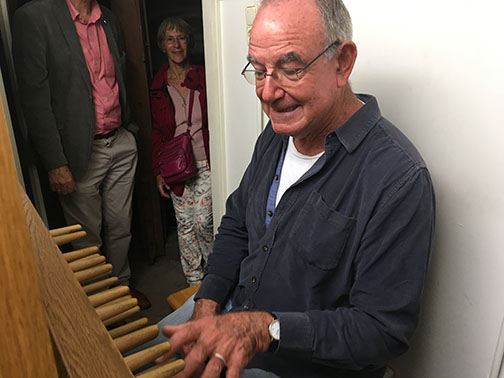In the tower of the Academy building, 168 steps above the street, Gabi Shefler (71) plays a dreamy melody on the carillon.
The retired professor of psychoanalysis and psychotherapy from Jerusalem made the trip to the Netherlands for a conference in Amsterdam, but also to visit old friends in Groningen. Acquaintances arranged for him to play the carillon.
‘This song is about Saturdays in Jerusalem, when the setting sun kisses the treetops’, he says, as his hands move fluidly over the wooden batons connected to the bells.
‘House carilloneur’ Auke de Boer shows Shefler two carillons: the one at the Martini tower and the one at the Academy building. While the instruments are similar, they also have some interesting differences: the heaviest bell at the Martini tower weighs eight tonnes, while the heaviest at the Academy building is ‘only’ 300 kilos. The Martini tower also has nearly twice as many batons (keys). This is exactly what makes the instrument so beautiful to both De Boer and Shefler.
Soaked with sweat
The carillon in Jerusalem is the only one in the Middle East. According to Shefler, it’s in disrepair. The bells can be played in dry weather, but the mechanism doesn’t run as smoothly as it once did. ‘After half an hour of playing I’m soaked with sweat. It’s hard work, physically speaking’, says Shefler.
He remembers how the then female carilloneur played the bells in Jerusalem when he was a boy: she had a completely different style, plucking at the batons rather than hitting them. He talks about home warmly: ‘We have a beautiful carillon in Jerusalem. I’m not just saying that to be patriotic.’
When the YMCA building, which houses the carillon, was built in 1925, it was all alone on top of a mountain. ‘I don’t quite understand why they built a carillon there of all places. Who was it for?’
Playing by ear
Shefler learned to play on that very same carillon, forty-five years ago. He wasn’t a great student; he didn’t like the strict lessons where he had to learn scales and read notes. He played music by ear, and by feeling. ‘If I can sing it, I can play it. Or rather: if I can think it, I can play it’, he says. He knows how to read notes, but he has trouble reading from left to right.
The professor has just retired, so he has more time now to play the bells. Is that why he came all the way to Groningen? No. ‘Friendship’, he laughs, pointing at his old Dutch university friends. That, and a conference about psychotherapeutic research in Amsterdam.
What if Shefler gets too old to play? He’s thought about it, he says. But now that he’s retired, he has time to teach others to play his favourite bells. That way, the Middle East will never be without a carilloneur.




